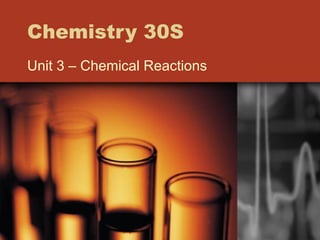
Stoichiometry
- 1. Chemistry 30S Unit 3 – Chemical Reactions
- 17. Stoichiometry Limiting Reactants (Reagents)
- 19. Limiting Reagents An analogy of limiting reactants could be the making of a cheese sandwich. Making this cheese sandwich (B 2 C) requires 2 slices of bread (B) and 1 slice of cheese (C). The equation for this sandwich would be 2 slices of bread + 1 slice of cheese = 1 cheese sandwich or 2 B + 1 C 1 B 2 C
- 20. Limiting Reagents 2 C 8 H 18 (l) + 25 O 2 (g) 16 CO 2 (g) + 18 H 2 O(l)
- 28. Limiting Reagent
- 29. Limiting Reagent
Notas del editor
- Let's try a simple example. Reactant A is a test tube. I have 20 of them. Reactant B is a stopper. I have 30 of them. Product C is a stoppered test tube. The reaction is: A + B ---> C or: test tube plus stopper gives stoppered test tube. So now we let them "react." The first stopper goes in, the second goes in and so on. Step by step we use up stoppers and test tubes (the amounts go down) and make stoppered test tubes (the amount goes up). Suddently, we run out of one of the "reactants." Which one? That's right. We run out of test tubes first. Seems obvious, doesn't it? We had 20 test tubes, but we had 30 stoppers. So when the test tubes are used up, we have 10 stoppers sitting thereunused. And we also have 20 test tubes with stoppers firmly inserted. So,what "reactant" is limiting and which is in excess?
- If we have 4 slices of bread and 2 slices of cheese, we can make exactly 2 sandwiches with nothing left. This has no limiting reactant. However, if we have 6 slices of bread and 2 slices of cheese, we can only make 2 sandwiches. We have enough bread to make 3 sandwiches but only enough cheese to make 2 sandwiches. The amount of cheese limits the amount of sandwiches we can make. The cheese is the limiting reactant and the bread is the excess reactant. In another example, if we have 8 slices of bread and 5 slices of cheese, we have enough bread to make 4 sandwiches and enough cheese to make 5 sandwiches. The bread is the limiting reactant in this example and cheese is the excess reactant, since some cheese will be left over.
- 1. Write a balanced equation for the reaction. 2 H2 + O2 2 H2O 2. Convert both reactant quantities to moles. 3. Using the mole ratio from the equation, determine the moles of water that could be formed by each reactant. 4. Oxygen produces the least amount of water. 16 grams of oxygen cannot produce as much water as 4 grams of hydrogen. In other words, 16 grams of oxygen will be used up in the reaction before 4 grams of hydrogen. Oxygen is the "limiting" reactant. Use oxygen for the calculation of product amount. 5. Complete the problem by converting moles of H2O to mass of H2O.
- 1. Write a balanced equation for the reaction. 2 H2 + O2 2 H2O 2. Convert both reactant quantities to moles. 3. Using the mole ratio from the equation, determine the moles of water that could be formed by each reactant. 4. Oxygen produces the least amount of water. 16 grams of oxygen cannot produce as much water as 4 grams of hydrogen. In other words, 16 grams of oxygen will be used up in the reaction before 4 grams of hydrogen. Oxygen is the "limiting" reactant. Use oxygen for the calculation of product amount. 5. Complete the problem by converting moles of H2O to mass of H2O.
- 1. Write a balanced equation for the reaction. 2 H2 + O2 2 H2O 2. Convert both reactant quantities to moles. 3. Using the mole ratio from the equation, determine the moles of water that could be formed by each reactant. 4. Oxygen produces the least amount of water. 16 grams of oxygen cannot produce as much water as 4 grams of hydrogen. In other words, 16 grams of oxygen will be used up in the reaction before 4 grams of hydrogen. Oxygen is the "limiting" reactant. Use oxygen for the calculation of product amount. 5. Complete the problem by converting moles of H2O to mass of H2O.
- 1. Write a balanced equation for the reaction. 2 H2 + O2 2 H2O 2. Convert both reactant quantities to moles. 3. Using the mole ratio from the equation, determine the moles of water that could be formed by each reactant. 4. Oxygen produces the least amount of water. 16 grams of oxygen cannot produce as much water as 4 grams of hydrogen. In other words, 16 grams of oxygen will be used up in the reaction before 4 grams of hydrogen. Oxygen is the "limiting" reactant. Use oxygen for the calculation of product amount. 5. Complete the problem by converting moles of H2O to mass of H2O.
- 1. Write a balanced equation for the reaction. 2 H2 + O2 2 H2O 2. Convert both reactant quantities to moles. 3. Using the mole ratio from the equation, determine the moles of water that could be formed by each reactant. 4. Oxygen produces the least amount of water. 16 grams of oxygen cannot produce as much water as 4 grams of hydrogen. In other words, 16 grams of oxygen will be used up in the reaction before 4 grams of hydrogen. Oxygen is the "limiting" reactant. Use oxygen for the calculation of product amount. 5. Complete the problem by converting moles of H2O to mass of H2O.
- 1 - calcium oxide 2. 0.78g of aluminum oxide 3a - AgNO3 3b - 26.6 g AgNO3 4a - H3PO4 4b - 2.85 g H2O 4c - 0.106 mole Na3PO4 4d - 10.15 g SO2
